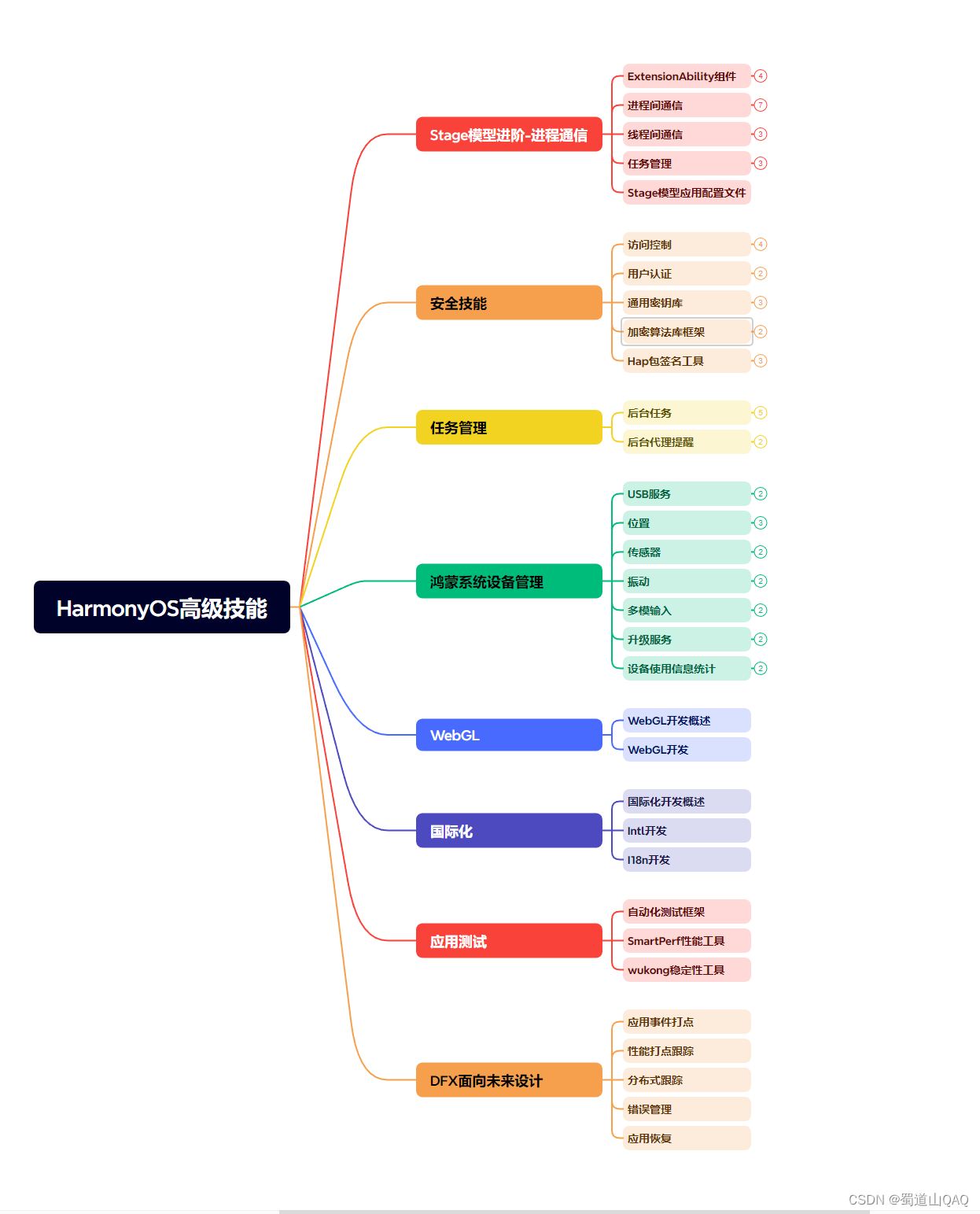属性动画是可动画属性的参数值发生变化时,引起UI上产生的连续视觉效果。当参数值发生连续变化,且设置到可以引起UI发生变化的属性接口上时,就可以实现属性动画。
ArkUI提供@AnimatableExtend装饰器,用于自定义可动画属性接口。由于参数的数据类型必须具备一定程度的连续性,自定义可动画属性接口的参数类型仅支持number类型和实现AnimtableArithmetic<T>接口的自定义类型。通过自定义可动画属性接口和可动画数据类型,在使用animateTo或animation执行动画时,通过逐帧回调函数修改不可动画属性接口的值,能够让不可动画属性接口实现动画效果。
使用number数据类型和@AnimatableExtend装饰器改变字体大小
// 第一步:使用@AnimatableExtend装饰器,自定义可动画属性接口
@AnimatableExtend(Text) function animatableFontSize(size: number) {
.fontSize(size) // 调用系统属性接口
}
@Entry
@Component
struct AnimatablePropertyExample {
@State fontSize: number = 20;
build() {
Column() {
Text("AnimatableProperty")
.animatableFontSize(this.fontSize) // 第二步:将自定义可动画属性接口设置到组件上
.animation({ duration: 1000, curve: "ease" }) // 第三步:为自定义可动画属性接口绑定动画
Button("Play")
.onClick(() => {
this.fontSize = this.fontSize == 20 ? 36 : 20; // 第四步:改变自定义可动画属性的参数,产生动画
})
}.width("100%")
.padding(10)
}
}
使用自定义数据类型和@AnimatableExtend装饰器改变折线
declare type Point = number[];
// 定义可动画属性接口的参数类型,实现AnimtableArithmetic<T>接口中加法、减法、乘法和判断相等函数
class PointClass extends Array<number> {
constructor(value: Point) {
super(value[0], value[1])
}
add(rhs: PointClass): PointClass {
let result: Point = new Array<number>() as Point;
for (let i = 0; i < 2; i++) {
result.push(rhs[i] + this[i])
}
return new PointClass(result);
}
subtract(rhs: PointClass): PointClass {
let result: Point = new Array<number>() as Point;
for (let i = 0; i < 2; i++) {
result.push(this[i] - rhs[i]);
}
return new PointClass(result);
}
multiply(scale: number): PointClass {
let result: Point = new Array<number>() as Point;
for (let i = 0; i < 2; i++) {
result.push(this[i] * scale)
}
return new PointClass(result);
}
}
// 定义可动画属性接口的参数类型,实现AnimtableArithmetic<T>接口中加法、减法、乘法和判断相等函数
// 模板T支持嵌套实现AnimtableArithmetic<T>的类型
class PointVector extends Array<PointClass> implements AnimatableArithmetic<Array<Point>> {
constructor(initialValue: Array<Point>) {
super();
if (initialValue.length) {
initialValue.forEach((p:Point) => this.push(new PointClass(p)))
}
}
// implement the IAnimatableArithmetic interface
plus(rhs: PointVector): PointVector {
let result = new PointVector([]);
const len = Math.min(this.length, rhs.length)
for (let i = 0; i < len; i++) {
result.push(this[i].add(rhs[i]))
}
return result;
}
subtract(rhs: PointVector): PointVector {
let result = new PointVector([]);
const len = Math.min(this.length, rhs.length)
for (let i = 0; i < len; i++) {
result.push(this[i].subtract(rhs[i]))
}
return result;
}
multiply(scale: number): PointVector {
let result = new PointVector([]);
for (let i = 0; i < this.length; i++) {
result.push(this[i].multiply(scale))
}
return result;
}
equals(rhs: PointVector): boolean {
if (this.length !== rhs.length) {
return false;
}
for (let index = 0, size = this.length; index < size; ++index) {
if (this[index][0] !== rhs[index][0] || this[index][1] !== rhs[index][1]) {
return false;
}
}
return true;
}
}
function randomInt(min:number, max:number) {
return Math.floor(Math.random() * (max - min) + min);
}
// 自定义可动画属性接口
@AnimatableExtend(Polyline) function animatablePoints(points: PointVector) {
.points(points)
}
// 自定义可动画属性接口
@AnimatableExtend(Text) function animatableFontSize(size: number) {
.fontSize(size)
}
@Entry
@Component
struct AnimatedShape {
@State pointVec1: PointVector = new PointVector([
[50, randomInt(0, 200)],
[100, randomInt(0, 200)],
[150, randomInt(0, 200)],
[250, randomInt(0, 200)],
[350, randomInt(0, 200)]
]);
@State pointVec2: PointVector = new PointVector([
[70, randomInt(0, 200)],
[120, randomInt(0, 200)],
[180, randomInt(0, 200)],
[220, randomInt(0, 200)],
[320, randomInt(0, 200)]
]);
@State color: Color = Color.Green;
@State fontSize: number = 20.0;
@State polyline1Vec: PointVector = this.pointVec1;
@State polyline2Vec: PointVector = this.pointVec2;
build() {
Column() {
Text("AnimatableExtend test")
.width(400)
.height(30)
.margin(1)
.fontSize(25)
.textAlign(TextAlign.Center)
.backgroundColor("#ffee44")
.border({ width: '1vp', color: "#88ff00", radius: 20, style: BorderStyle.Solid })
Polyline()
.width(400)
.height(240)
.backgroundColor("#eeaacc")
.fill(this.color)
.stroke(Color.Red)
.animatablePoints(this.polyline1Vec)
.animation({ duration: 2000, delay: 0, curve: Curve.Ease })
Polyline()
.width(400)
.height(240)
.backgroundColor("#bbffcc")
.fill(this.color)
.stroke(Color.Red)
.animatablePoints(this.polyline2Vec)
.animation({ duration: 2000, delay: 0, curve: Curve.Ease })
Text("Animatable Fontsize")
.animatableFontSize(this.fontSize)
.animation({ duration: 2000, delay: 0, curve: Curve.Ease })
.width(400)
.height(150)
.margin(5)
.textAlign(TextAlign.Center)
.backgroundColor("#ffddcc")
.border({ width: '2vp', color: "#88ff00", radius: 20, style: BorderStyle.Solid })
.onClick(() => {
console.log("Text onClick()")
})
Row() {
Button("Polyline1 default")
.width(100).height(60)
.margin({ left: 5, right: 5 })
.padding(10)
.onClick(() => {
if (this.polyline1Vec.equals(this.pointVec1)) {
this.polyline1Vec = this.pointVec2;
} else {
this.polyline1Vec = this.pointVec1;
}
})
Button("Polyline2 ANIM")
.width(100).height(60)
.onClick(() => {
if (this.polyline2Vec.equals(this.pointVec1)) {
this.polyline2Vec = this.pointVec2;
} else {
this.polyline2Vec = this.pointVec1;
}
})
Button("FontSize")
.width(100).height(60)
.margin({ left: 5, right: 5 })
.onClick(() => {
this.fontSize = (this.fontSize == 20.0) ? 40.0 : 20.0;
})
}
.alignItems(VerticalAlign.Center)
.margin(5)
}
.width('100%')
.alignItems(HorizontalAlign.Center)
}
}
最后
有很多小伙伴不知道学习哪些鸿蒙开发技术?不知道需要重点掌握哪些鸿蒙应用开发知识点?而且学习时频繁踩坑,最终浪费大量时间。所以有一份实用的鸿蒙(HarmonyOS NEXT)资料用来跟着学习是非常有必要的。
这份鸿蒙(HarmonyOS NEXT)资料包含了鸿蒙开发必掌握的核心知识要点,内容包含了(ArkTS、ArkUI开发组件、Stage模型、多端部署、分布式应用开发、音频、视频、WebGL、OpenHarmony多媒体技术、Napi组件、OpenHarmony内核、Harmony南向开发、鸿蒙项目实战等等)鸿蒙(HarmonyOS NEXT)技术知识点。
希望这一份鸿蒙学习资料能够给大家带来帮助,有需要的小伙伴自行领取,限时开源,先到先得~无套路领取!!
获取这份完整版高清学习路线,请点击→纯血版全套鸿蒙HarmonyOS学习资料
鸿蒙(HarmonyOS NEXT)最新学习路线

-
HarmonOS基础技能

- HarmonOS就业必备技能

- HarmonOS多媒体技术

- 鸿蒙NaPi组件进阶

- HarmonOS高级技能

- 初识HarmonOS内核

- 实战就业级设备开发

有了路线图,怎么能没有学习资料呢,小编也准备了一份联合鸿蒙官方发布笔记整理收纳的一套系统性的鸿蒙(OpenHarmony )学习手册(共计1236页)与鸿蒙(OpenHarmony )开发入门教学视频,内容包含:ArkTS、ArkUI、Web开发、应用模型、资源分类…等知识点。
获取以上完整版高清学习路线,请点击→纯血版全套鸿蒙HarmonyOS学习资料
《鸿蒙 (OpenHarmony)开发入门教学视频》

《鸿蒙生态应用开发V2.0白皮书》

《鸿蒙 (OpenHarmony)开发基础到实战手册》
OpenHarmony北向、南向开发环境搭建

《鸿蒙开发基础》
- ArkTS语言
- 安装DevEco Studio
- 运用你的第一个ArkTS应用
- ArkUI声明式UI开发
- .……

《鸿蒙开发进阶》
- Stage模型入门
- 网络管理
- 数据管理
- 电话服务
- 分布式应用开发
- 通知与窗口管理
- 多媒体技术
- 安全技能
- 任务管理
- WebGL
- 国际化开发
- 应用测试
- DFX面向未来设计
- 鸿蒙系统移植和裁剪定制
- ……

《鸿蒙进阶实战》
- ArkTS实践
- UIAbility应用
- 网络案例
- ……

获取以上完整鸿蒙HarmonyOS学习资料,请点击→纯血版全套鸿蒙HarmonyOS学习资料
总结
总的来说,华为鸿蒙不再兼容安卓,对中年程序员来说是一个挑战,也是一个机会。只有积极应对变化,不断学习和提升自己,他们才能在这个变革的时代中立于不败之地。






















 434
434

 被折叠的 条评论
为什么被折叠?
被折叠的 条评论
为什么被折叠?








